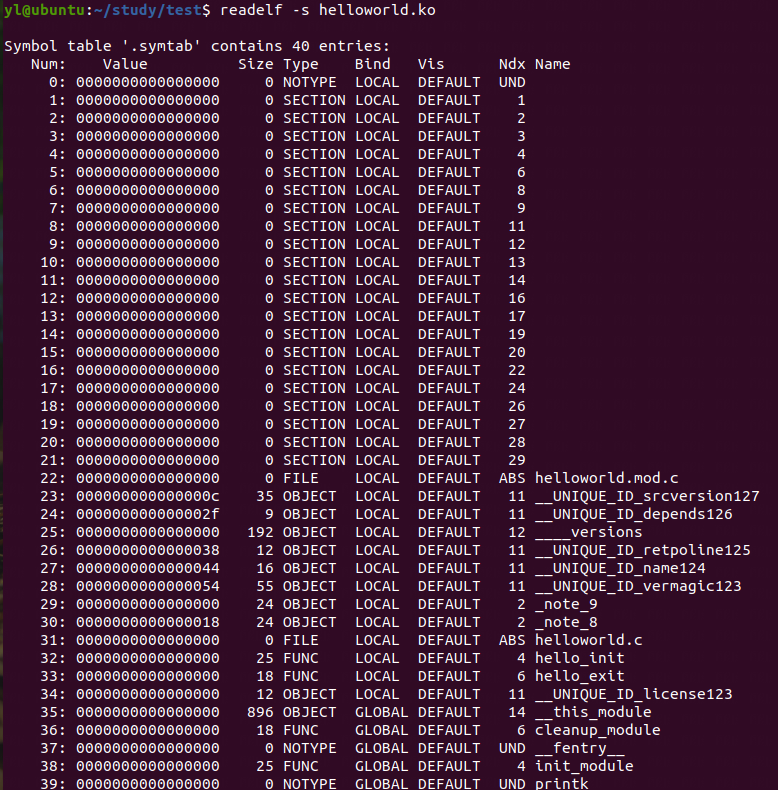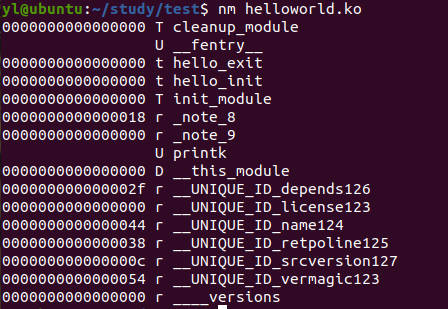文章目录
前言
最近学习了Linux内核模块的符号信息和 strip 命令,总结一下。
一、strip
1.1 GNU Binutils
GNU Binutils 是二进制工具的集合。 主要有:
ld - the GNU linker.
as - the GNU assembler.
其他常用的一些工具:
ar - A utility for creating, modifying and extracting from archives.
nm - Lists symbols from object files.
objcopy - Copies and translates object files.
objdump - Displays information from object files.
readelf - Displays information from any ELF format object file.
size - Lists the section sizes of an object or archive file.
strings - Lists printable strings from files.
strip - Discards symbols.
......
binutils 已被移植到大多数主要的 Unix variants 中,是为GNU系统(以及GNU/Linux)提供编译和链接程序的工具。
本文主要介绍strip命令的使用。
1.2 strip
(1)
strip - Discard symbols from object files.
Discard 目标文件 objfile 中的符号。
(2)
-s
--strip-all
Remove all symbols.
-g
-S
-d
--strip-debug
Remove debugging symbols only.
(3)
--info
Display a list showing all architectures and object formats available.

二、使用步骤
1.1 demo
我以一个简单的内核模块为例子:
#include <linux/kernel.h>
#include <linux/module.h>
//内核模块初始化函数
static int __init hello_init(void)
{
printk(KERN_EMERG "Hello World\n");
return 0;
}
//内核模块退出函数
static void __exit hello_exit(void)
{
printk(KERN_DEBUG "exit\n");
}
module_init(hello_init);
module_exit(hello_exit);
MODULE_LICENSE("GPL");
编译出来的内核模块:

可以看出内核模块带有debug_info信息,所以导致文件大小比较大。
readelf -S helloworld.ko

有很多带debug的Section。
1.2 strip --strip-debug
我用 strip --strip-debug 命令去除内核模块的调试信息:
strip --strip-debug helloworld.ko

可见调试信息没有了,内核模块一下小了很多。
readelf -S helloworld.ko

没有带有debug的Section。
依然能够正常使用内核模块:

1.3 符号信息
1.3.1 查看模块的符号信息
readelf -s helloworld.ko
-s
--symbols
--syms
Displays the entries in symbol table section of the file, if it has one.

nm helloworld.ko

1.3.2 符号表
(1)
symtab 保存了二进制文件的符号表,符号表保存了查找程序符号、为符合赋值,重定位符号所需要的全部信息。有一个专门的section来保存符号表。符号表表项的格式由下列数据结构表示:
/* Symbol table entry. */
typedef struct
{
Elf64_Word st_name; /* Symbol name (string tbl index) */
unsigned char st_info; /* Symbol type and binding */
unsigned char st_other; /* Symbol visibility */
Elf64_Section st_shndx; /* Section index */
Elf64_Addr st_value; /* Symbol value */
Elf64_Xword st_size; /* Symbol size */
} Elf64_Sym;
符号的主要任务是将一个字符串和一个值关联起来。
(2)
一个符号的确切用途由st_info定义,由两部分组成:Symbol type 和 Symbol binding。
/* How to extract and insert information held in the st_info field. */
#define ELF32_ST_BIND(val) (((unsigned char) (val)) >> 4)
#define ELF32_ST_TYPE(val) ((val) & 0xf)
#define ELF32_ST_INFO(bind, type) (((bind) << 4) + ((type) & 0xf))
/* Both Elf32_Sym and Elf64_Sym use the same one-byte st_info field. */
#define ELF64_ST_BIND(val) ELF32_ST_BIND (val)
#define ELF64_ST_TYPE(val) ELF32_ST_TYPE (val)
#define ELF64_ST_INFO(bind, type) ELF32_ST_INFO ((bind), (type))
(3)
Symbol type:
/* Legal values for ST_TYPE subfield of st_info (symbol type). */
#define STT_NOTYPE 0 /* Symbol type is unspecified */
#define STT_OBJECT 1 /* Symbol is a data object */
#define STT_FUNC 2 /* Symbol is a code object */
#define STT_SECTION 3 /* Symbol associated with a section */
#define STT_FILE 4 /* Symbol's name is file name */
#define STT_COMMON 5 /* Symbol is a common data object */
#define STT_TLS 6 /* Symbol is thread-local data object*/
#define STT_NUM 7 /* Number of defined types. */
#define STT_LOOS 10 /* Start of OS-specific */
#define STT_GNU_IFUNC 10 /* Symbol is indirect code object */
#define STT_HIOS 12 /* End of OS-specific */
#define STT_LOPROC 13 /* Start of processor-specific */
#define STT_HIPROC 15 /* End of processor-specific */
主要说明三个:
STT_NOTYPE:表示符号的类型未指定,用于未定义引用。
STT_OBJECT:表示符号关联到一个数据对象,比如变量、数组或指针。
STT_FUNC:表示符号关联到一个代码对象,比如函数或过程。
(4)
Symbol binding:
/* Legal values for ST_BIND subfield of st_info (symbol binding). */
#define STB_LOCAL 0 /* Local symbol */
#define STB_GLOBAL 1 /* Global symbol */
#define STB_WEAK 2 /* Weak symbol */
#define STB_NUM 3 /* Number of defined types. */
#define STB_LOOS 10 /* Start of OS-specific */
#define STB_GNU_UNIQUE 10 /* Unique symbol. */
#define STB_HIOS 12 /* End of OS-specific */
#define STB_LOPROC 13 /* Start of processor-specific */
#define STB_HIPROC 15 /* End of processor-specific */
主要说明三个:
STB_LOCAL:局部符号,只在目标文件内部可见,在与其它程序的其它部分合并时,是不可见的。如果一个程序的几个目标文件都定义相同的符号名,也不会有问题。局部符号互不干扰。
STB_GLOBAL:全局符号,在定义的目标文件内部可见,也可以由构成的其他目标文件引用。每个全局符号在一个程序内部都只能定义一次,否则链接器将报告错误。
指向符号的未定义引用,将在重定位期间确定相关符号的位置。如果对全局符号的未定义引用无法解决,则拒绝程序执行或静态绑定。
STB_WEAK:整个程序内可见,但可以有多个定义。如果程序中一个全局符号和一个局部符号名字相同,全局符号优先处理。
即使一个弱符号未定义,程序也可以静态或动态链接,并将符号指定为0值。
1.3.3 strip -s
strip -s helloworld.ko
去除模块的所有符号:

二进制模块的符号信息全部被strip,如下所示:

去除所有模块后,内核模块不能正常加载:

总结
本文是内核模块符号表的一些内容以及strip命令的使用。
参考资料
深入Linux内核架构
https://www.gnu.org/software/binutils/